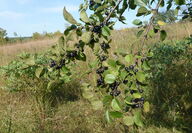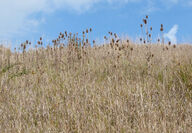Sorted by date Results 1 - 8 of 8

Invasive plants are non-native and cause harm. Many invasive plant species in Minnesota are regulated as noxious weeds. Most of us encounter invasive plants in our communities when we are out recreating or working outdoors. Fortunately, there are resources to help us identify and manage invasive plants. Basic invasive plant identification, regulation, and management: • The Minnesota Department of Transportation's online book "Minnesota Noxious Weeds" is helpful for learning about priority i...

Tree of heaven (Ailanthus altissima) is a fast-growing, prolific seed producer that is a Prohibited Eradicate Noxious Weed in Minnesota. Native to China, Mongolia, Taiwan, and Tibet, it was introduced to North America as an ornamental shade tree. In urban areas, it can cause damage to sewers, pavement, and building foundations. In natural ecosystems, it can establish dense monocultures that outcompete native plants. Tree of heaven can reach heights of 80 feet. Tree of heaven looks like staghorn...

At least one million common barberry (Berberis vulgaris) plants were destroyed in Minnesota from 1918 to 1990 in a joint state and federal eradication program. Common barberry hosts black stem rust (Puccinia graminis), a pathogen that historically caused yield losses of up to 70% of wheat, barley, and other small grains over large areas. Since the 1950s, small grains in production have been protected from this pathogen by scientists breeding plants resistant to existing strains of black stem...

The Urban Roots Youth Crew said, "We can do it!" That's after David Woods pronounced a buckthorn shrub too large to pull. "They consistently rise to challenges," said Woods, Conservation Program Director for Urban Roots. These crews face the daunting task of managing noxious and invasive weeds to restore native habitat. Urban Roots trains youth interns in leadership, entrepreneurial, and life skills through their Market Garden, Conservation, and Cook Fresh programs. Interns are 14-18 years old...

Red hailstone (Thladiantha dubia) is an herbaceous vine named for the red fruit on female plants. The vines grow vigorously to climb over other vegetation enabling red hailstone to dominate. It smothers native vegetation and has been problematic in agricultural fields. Within the United States, red hailstone has been found in Illinois, Massachusetts, Michigan, Minnesota, New Hampshire, New York, and Wisconsin. Minnesota infestations are in Linwood (Anoka County), Watertown (Carver County),...

Invasive plant problems in Minnesota can feel overwhelming. One example is common buckthorn (Rhamnus cathartica). Common buckthorn is an invasive tree or shrub that crowds out forest understories. When forests understories are shaded by common buckthorn, native tree saplings and wildflowers don't regenerate. Additionally, soybean aphids overwinter on buckthorn thereby maintaining soybean aphid populations. Unfortunately, common buckthorn is abundant in many areas of Minnesota. It is cost-prohibi...

The sweet fragrance of Japanese honeysuckle flowers, often described as heavenly, lures pollinators long distances. In addition, Japanese honeysuckle (Lonicera japonica) is an attractive woody vine that can grow up to 80 feet long. It was widely planted in southern and central states for both ornamental and erosion control purposes. Unlike the abundant and damaging non-native bush honeysuckles that are shrubs, Japanese honeysuckle is a vine. The leaves are simple. Pairs of leaves and flowers...

What died in a cemetery but its offspring escaped alive? You guessed it - invasive plant seeds that escaped from floral arrangements. People have been using invasive plants in funeral arrangements for over a century in North America. People used common tansy (Tanacetum vulgare) in coffins to repel insects and worms, including in the coffin of Harvard University's first president. After becoming a mainstay at New England funerals, people began to loath tansy due to its association with death....